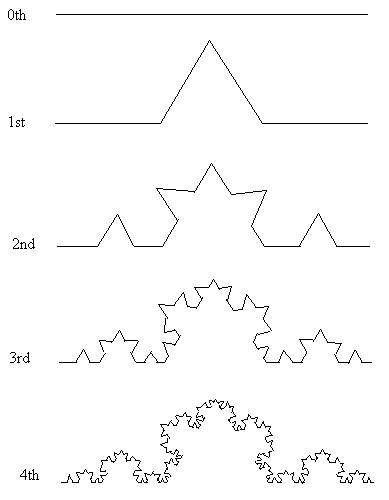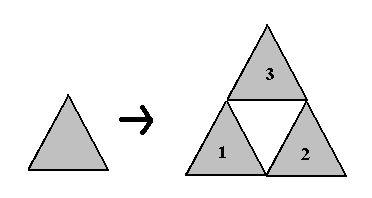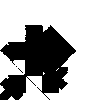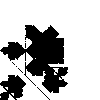
This not a fractal:
- Doesn't have detail at all levels
- Not self-similar
- It is made with an iterative process, but not an infinite one
- Does not have a fractional dimension
| Iteration: | Length: |
| 0 | 1 |
| 1 | 4/3 |
| 2 | 16/9 = (4/3)² |
| n | (4/3)n |
Length goes to infinity.
| Iteration: | Area remaining: |
| 0 | 1 |
| 1 | 3/4 |
| 2 | 9/16 = (3/4)2 |
| n | (3/4)n |
Area goes to zero.
You can also use the area removed from the triangle, and sigma notation, to show that the area removed goes to 1, the same as the starting area.
| Iteration: | Area removed: |
| 0 | 0 |
| 1 | 1/4 |
| 2 | 1/4 + 3/16 |
| 3 | 1/4 + 3/16 + 9/64 |
| n | Σi=1 to n (3i-1)/(4i) |
Area removed goes to one, the original area, so all area is removed.
The formula for calculating dimension is: (magnification factor)dimension = size change

From the image, we can see that if we magnify the fractal by two, we need three copies of the original fractal to make the new one.
Thus, we have: 2d = 3 ⇒ d = ln3/ln2 ≈ 1.585
- Scale down to .707 of the original size in both directions Place this image rotated 45 degrees clockwise, centered in the original square.
- Scale down by a factor of 3 in both directions, place the image upside-down with its base touching the bottom of the square, and centered.
- Scale down by a factor of 3 in each direction, and place it in the lower left-hand corner.
- Start with ANY square non-blank image of your choice.
Use a scaling photocopy machine, scissors and tape to create a 3rd
iteration of the above iterated function system. Turn in the
original image, the 1st, 2nd, and 3rd images.
Sample transformationIteration: Image: Iteration: Image: 0 
3 
1 
4 
2 
- Before you begin, tell me how many photocopies you will have to make
to get the final product (if you don't make any mistakes.)
Each iteration takes 3 photocopies, so to get to the third iteration is a total of 9 photocopies. If you count the original as one, then 10 copies are required. Either answer is acceptable.
- Write down the matrices that describe these 3 linear transformations.
There were several possible variations of these matrices. One big difference is where you consider the origin to be.
If the origin is in the lower left of the original image, the transformations are:-
| 1/2 1/2||x| + | 0 | = |x'| |-1/2 1/2||y| |1/2| |y'|
-
|-1/3 0 ||x| + |2/3| = |x'| | 0 -1/3||y| |1/3| |y'|
-
|1/3 0 ||x| + |0| = |x'| | 0 1/3||y| |0| |y'|
-
| 1/2 1/2||x| + |0| = |x'| |-1/2 1/2||y| |0| |y'|
-
|-1/3 0 ||x| + | 0 | = |x'| | 0 -1/3||y| |-1/3| |y'|
-
|1/3 0 ||x| + |-1/3| = |x'| | 0 1/3||y| |-1/3| |y'|
-
| Origin lower left: | Origin centered: | |
| Starting point: | (0,0) | (0,0) |
| Function 1: | (0,1/2) | (0,0) |
| Function 3: | (0,1/6) | (-1/3,-1/3) |
| Function 2: | (2/3,5/18) | (1/9,-1/9) |